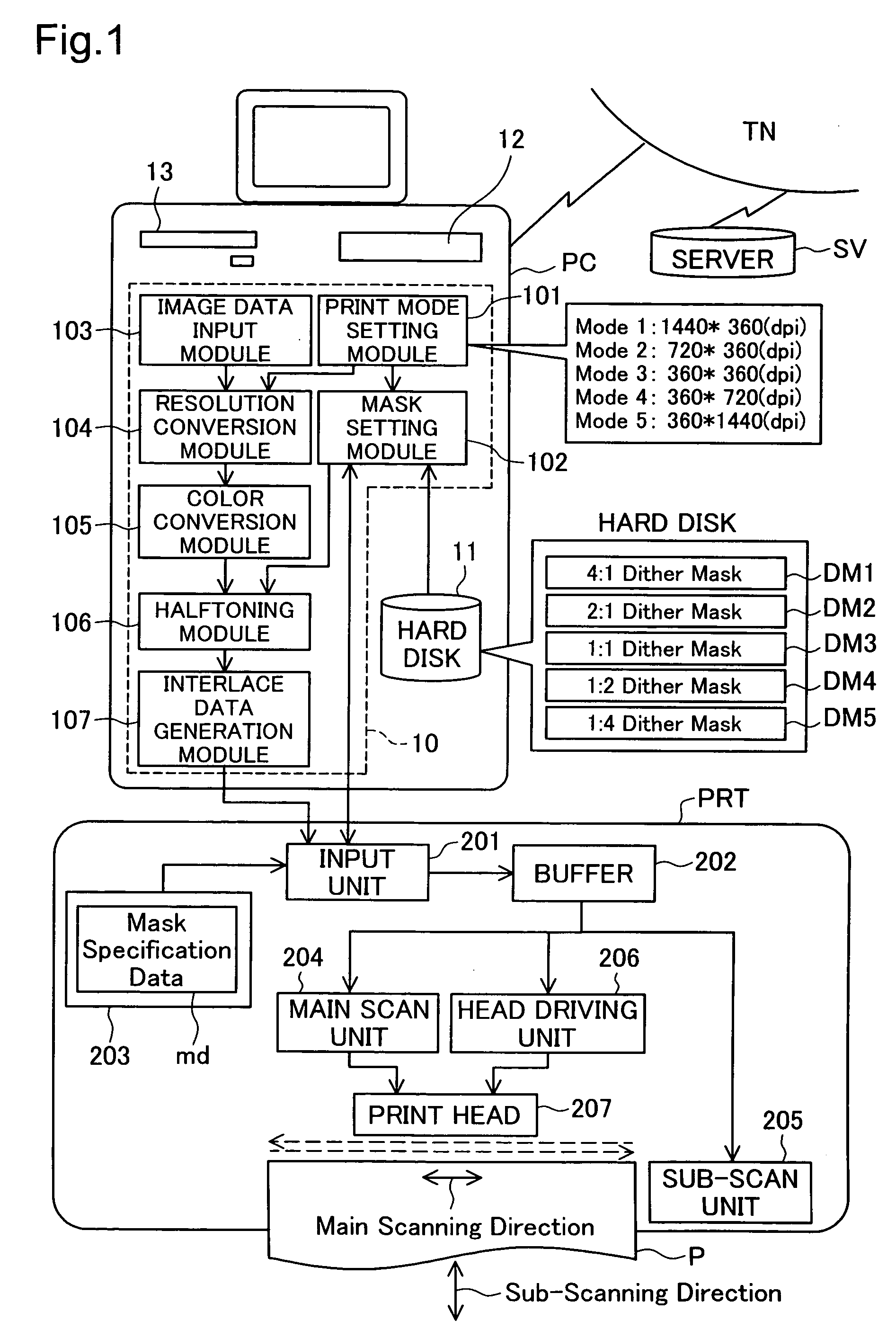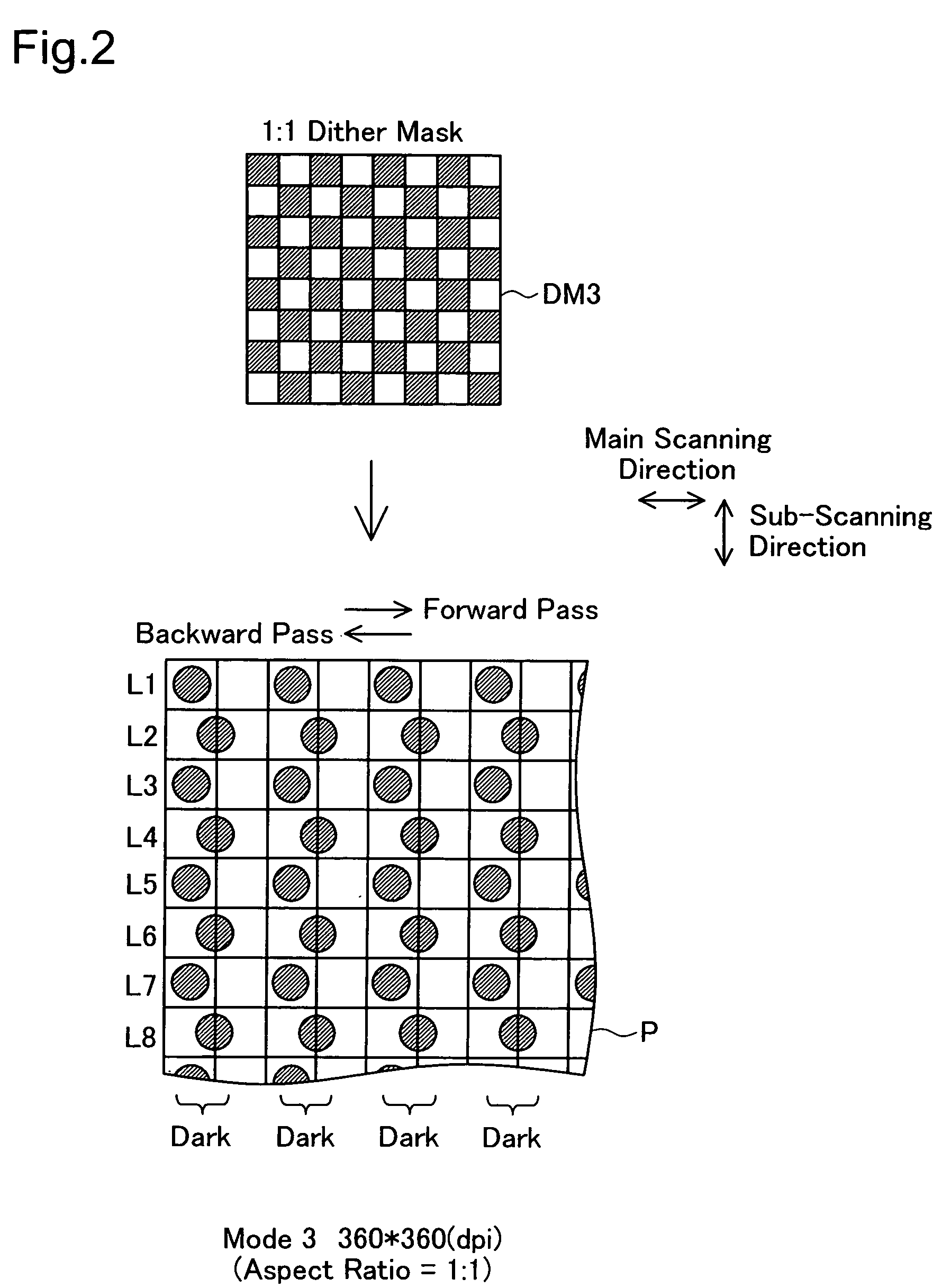Image processing device and dot data generation method
a technology of image processing device and dot data, which is applied in the direction of digital computers, visual presentations, instruments, etc., can solve the problems of uneven printing, achieve the effect of reducing the cost of printing system, reducing the possibility of uneven printing, and increasing the manufacturing cos
- Summary
- Abstract
- Description
- Claims
- Application Information
AI Technical Summary
Benefits of technology
Problems solved by technology
Method used
Image
Examples
first embodiment
A. First Embodiment
A-1. System Configuration
[0059]FIG. 1 schematically illustrates the configuration of a printing system in a first embodiment of the invention. In the printing system of FIG. 1, a printer PRT is connected to a computer PC and receives print data generated by a printer driver 10 installed in the computer PC to perform a printing operation. The print data includes raster data representing the dot on-off state of respective pixels on rasters and sub-scan feed data representing a feed amount of printing paper in each sub-scan. The computer PC and the raster data of this embodiment are respectively equivalent to the image processing device and the dot data of the invention.
[0060] The computer PC includes a hard disk 11, a CD-ROM drive 12, a flexible disk drive 13, as well as a CPU, memories, and an interface card (not shown).
[0061] The computer PC is connected to an external network TN via the non-illustrated interface card and may have access to a selected server SV...
second embodiment
B. Second Embodiment
[0130] A second embodiment of the invention adopts another known technique, the error diffusion method, to the halftoning process, while the first embodiment described above adopts the known systematic dither method to the halftoning process.
B-1. System Configuration
[0131]FIG. 10 schematically illustrates the configuration of a printing system in the second embodiment of the invention. The printing system of the second embodiment shown in FIG. 10 has only some differences in configuration from the printing system of the first embodiment shown in FIG. 1.
[0132] In the printing system of the second embodiment, a halftoning module 110 included in a printer driver 15 of the computer PC is different from the halftoning module 106 of the first embodiment shown in FIG. 1 and includes five error diffusion processing units corresponding to five available aspect ratios:
[0133] (1) 4:1 error diffusion processing unit GS1
[0134] (2) 2:1 error diffusion processing unit GS2
[0...
modified example 1
C1. Modified Example 1
[0171] In the first and the second embodiments discussed above, a positional misalignment of dots in the main scanning direction causes an uneven printing problem in the main scanning direction. The technique of the invention is also applicable to prevent the occurrence of uneven printing in the sub-scanning direction due to a positional misalignment of dots in the sub-scanning direction.
[0172] The uneven printing problem in the sub-scanning direction may be caused by deviation of the positions of nozzle holes from their design positions in the sub-scanning direction or by deviation of the actual feed amount of printing paper from its designed feed amount, for example, due to an attachment failure of a paper feed roller.
[0173] In one example, a resulting image printed in Mode 3 with the 1 to 1 aspect ratio (360 (dpi)×360 (dpi)) has an uneven printing problem in the sub-scanning direction, which is eliminated by the wider dot interval. In this case, the halfto...
PUM
 Login to View More
Login to View More Abstract
Description
Claims
Application Information
 Login to View More
Login to View More - R&D
- Intellectual Property
- Life Sciences
- Materials
- Tech Scout
- Unparalleled Data Quality
- Higher Quality Content
- 60% Fewer Hallucinations
Browse by: Latest US Patents, China's latest patents, Technical Efficacy Thesaurus, Application Domain, Technology Topic, Popular Technical Reports.
© 2025 PatSnap. All rights reserved.Legal|Privacy policy|Modern Slavery Act Transparency Statement|Sitemap|About US| Contact US: help@patsnap.com



